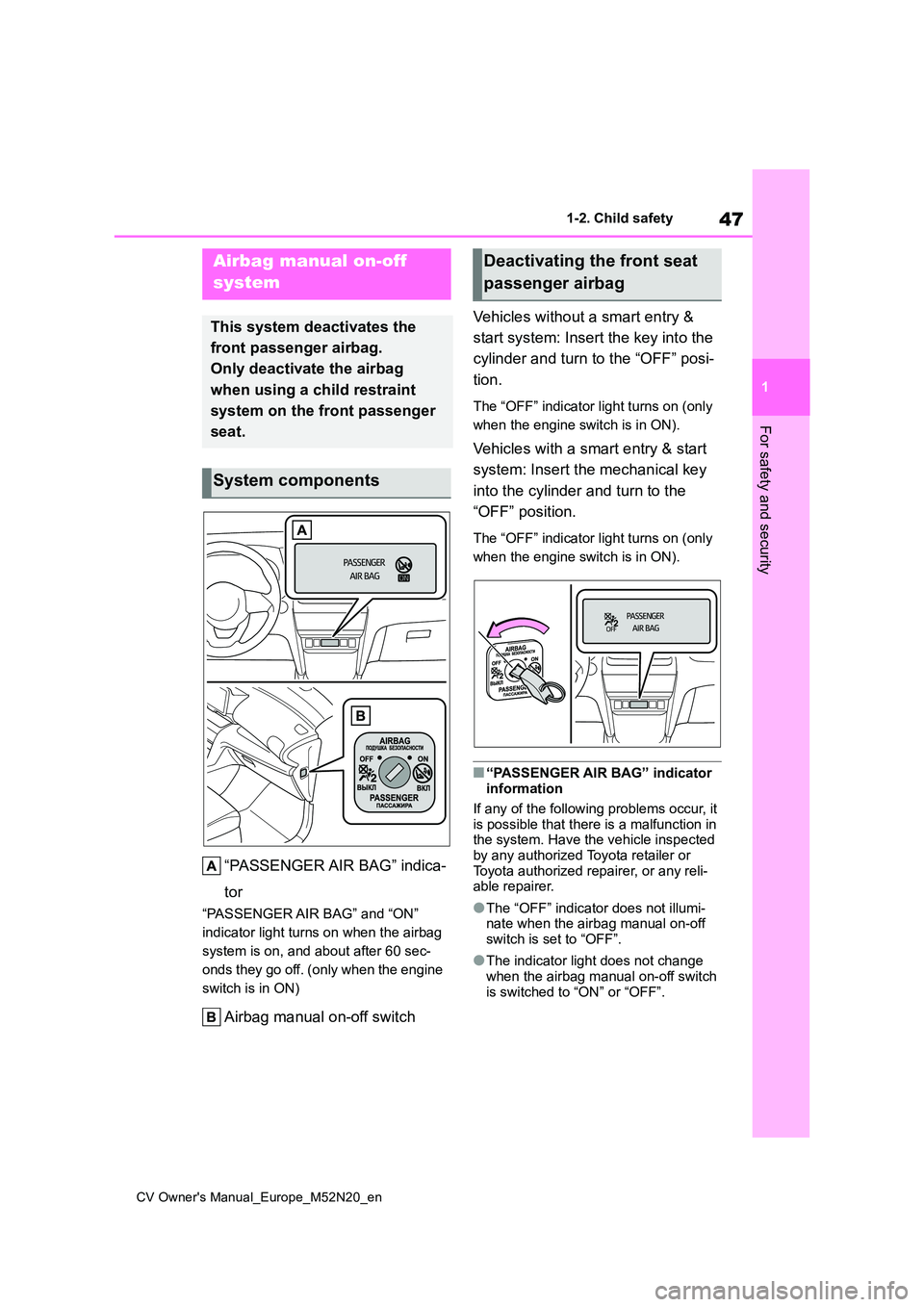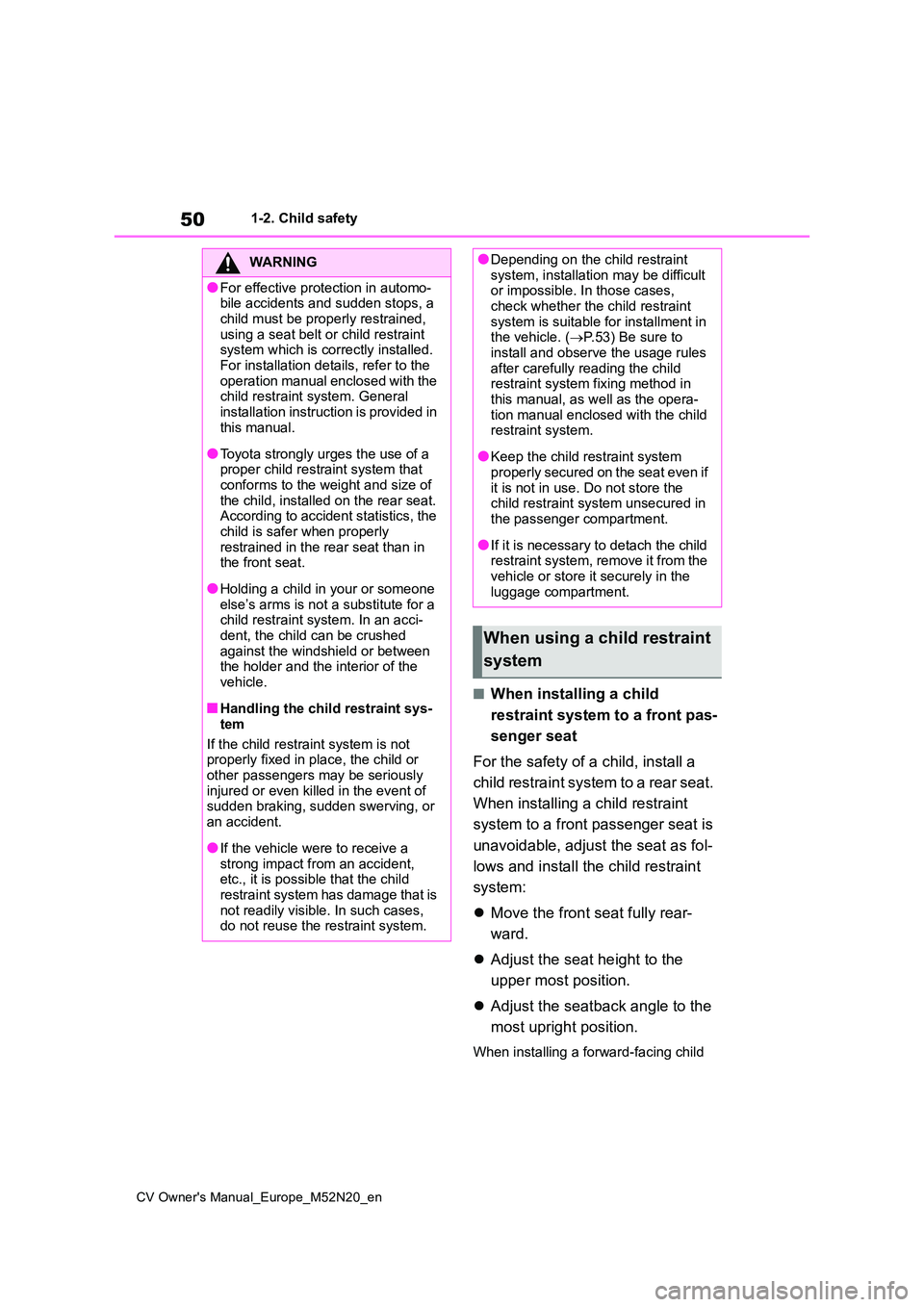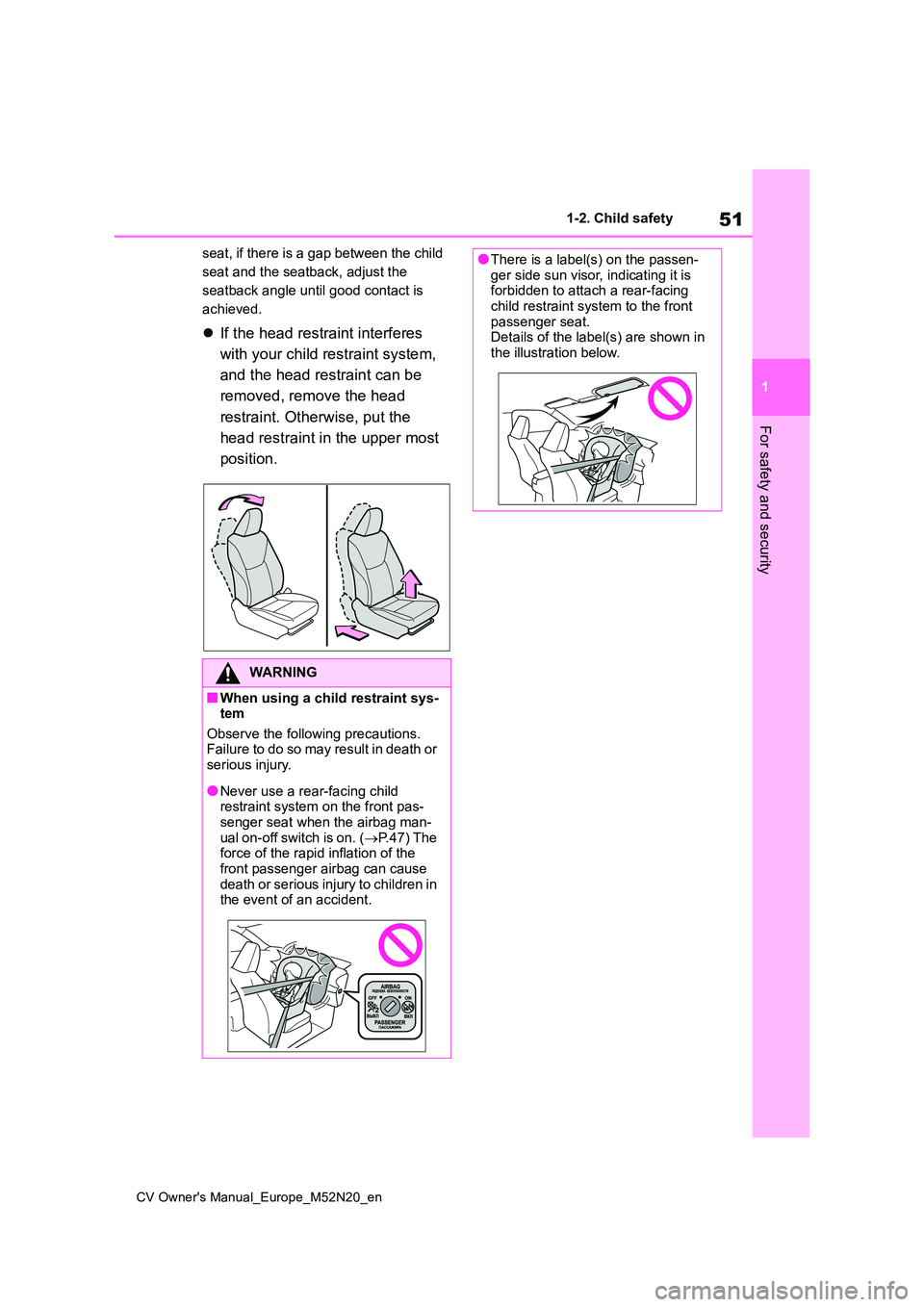2022 TOYOTA YARIS CROSS ECU
[x] Cancel search: ECUPage 43 of 618
![TOYOTA YARIS CROSS 2022 Owners Manual 41
1
CV Owner's Manual_Europe_M52N20_en
1-1. For safe use
For safety and security
from a direction perpendicular to the
vehicle orientation at an approximate speed of 20 - 30 km/h [12 - 18 mph] TOYOTA YARIS CROSS 2022 Owners Manual 41
1
CV Owner's Manual_Europe_M52N20_en
1-1. For safe use
For safety and security
from a direction perpendicular to the
vehicle orientation at an approximate speed of 20 - 30 km/h [12 - 18 mph]](/manual-img/14/60819/w960_60819-42.png)
41
1
CV Owner's Manual_Europe_M52N20_en
1-1. For safe use
For safety and security
from a direction perpendicular to the
vehicle orientation at an approximate speed of 20 - 30 km/h [12 - 18 mph]).
●Both SRS curtain shield airbags may deploy in the event of a severe side collision.
●Both SRS curtain shield airbags may also deploy in the event of a severe
frontal collision.
■Conditions under which the SRS airbags may deploy (inflate), other than a collision
The SRS front airbags and SRS side and curtain shield airbags may also deploy if a serious impact occurs to the
underside of your vehicle. Some exam- ples are shown in the illustration.
●Hitting a curb, edge of pavement or hard surface
●Falling into or jumping over a deep hole
●Landing hard or falling
■Types of collisions that may not
deploy the SRS airbags (SRS front airbags)
The SRS front airbags do not generally
inflate if the vehicle is involved in a side or rear collision, if it rolls over, or if it is involved in a low-speed frontal collision.
But, whenever a collision of any type causes sufficient forward deceleration of the vehicle, deployment of the SRS front
airbags may occur.
●Collision from the side
●Collision from the rear
●Vehicle rollover
■Types of collisions that may not
deploy the SRS airbags (SRS side and curtain shield airbags and SRS front seat center airbags)
The SRS side and curtain shield airbags and SRS front seat center airbags may not activate if the vehicle is subjected to
a collision from the side at certain angles, or a collision to the side of the vehicle body other than the passenger
compartment.
●Collision from the side to the vehicle
body other than the passenger com- partment
●Collision from the side at an angle
The SRS side airbags and SRS front
seat center airbags do not generally inflate if the vehicle is involved in a fron-tal or rear collision, if it rolls over, or if it
is involved in a low-speed side collision.
●Collision from the front
●Collision from the rear
●Vehicle rollover
Page 45 of 618

43
1
CV Owner's Manual_Europe_M52N20_en
1-1. For safe use
For safety and security
WARNING
■SRS airbag precautions
Observe the following precautions
regarding the SRS airbags. Failure to do so may cause death or serious injury.
●The driver and all passengers in the vehicle must wear their seat belts
properly. The SRS airbags are supplemental devices to be used with the seat
belts.
●The SRS driver airbag deploys with
considerable force, and can cause death or serious injury especially if the driver is very close to the air-
bag.
Since the risk zone for the driver’s air-
bag is the first 50 - 75 mm (2 - 3 in.) of
inflation, placing yourself 250 mm (10
in.) from your driver airbag provides
you with a clear margin of safety. This
distance is measured from the center
of the steering wheel to your breast-
bone. If you sit less than 250 mm (10
in.) away now, you can change your
driving position in several ways:
• Move your seat to the rear as far as you can while still reaching the ped-als comfortably.
• Slightly recline the back of the seat.Although vehicle designs vary, many drivers can achieve the 250
mm (10 in.) distance, even with the driver seat all the way forward, sim-ply by reclining the back of the seat
somewhat. If reclining the back of your seat makes it hard to see the road, raise yourself by using a firm,
non-slippery cushion, or raise the seat if your vehicle has that feature.
• If your steering wheel is adjustable, tilt it downward. This points the air-bag toward your chest instead of
your head and neck.
The seat should be adjusted as rec-
ommended above, while still main- taining control of the foot pedals, steering wheel, and your view of the
instrument panel controls.
●The SRS front passenger airbag
also deploys with considerable force, and can cause death or seri-ous injury especially if the front pas-
senger is very close to the airbag. The front passenger seat should be as far from the airbag as possible
with the seatback adjusted, so the front passenger sits upright.
●Improperly seated and/or restrained infants and children can be killed or seriously injured by a deploying air-
bag. An infant or child who is too small to use a seat belt should be properly secured using a child
restraint system. Toyota strongly recommends that all infants and children be placed in the rear seats
of the vehicle and properly restrained. The rear seats are safer for infants and children than the
front passenger seat. ( P. 4 9 )
Page 47 of 618

45
1
CV Owner's Manual_Europe_M52N20_en
1-1. For safe use
For safety and security
WARNING
●Do not use seat accessories which cover the parts where the SRS side
airbags and SRS front seat center airbags inflate as they may interfere with inflation of the SRS airbags.
Such accessories may prevent the SRS side airbags and SRS front seat center airbags from activating
correctly, disable the system or cause the SRS side airbags and SRS front seat center airbags to
inflate accidentally, resulting in death or serious injury.
●Do not strike or apply significant levels of force to the area of the SRS airbag components or the
front doors. Doing so can cause the SRS air-bags to malfunction.
●Do not touch any of the component parts immediately after the SRS air-
bags have deployed (inflated) as they may be hot.
●If breathing becomes difficult after the SRS airbags have deployed, open a door or window to allow
fresh air in, or leave the vehicle if it is safe to do so. Wash off any resi-due as soon as possible to prevent
skin irritation.
●If the areas where the SRS airbags
are stored, such as the steering wheel pad and front and rear pillar garnishes, are damaged or
cracked, have them replaced by any authorized Toyota retailer or Toyota authorized repairer, or any
reliable repairer.
■Modification and disposal of SRS airbag system components
Do not dispose of your vehicle or per-
form any of the following modifica- tions without consulting your Toyota retailer or Toyota authorized repairer,
or any reliable repairer. The SRS air- bags may malfunction or deploy (inflate) accidentally, causing death or
serious injury.
●Installation, removal, disassembly
and repair of the SRS airbags
●Repairs, modifications, removal or
replacement of the steering wheel, instrument panel, dashboard, seats or seat upholstery, front, side and
rear pillars, roof side rails, front door panels, front door trims or front door speakers
●Modifications to the front door panel (such as making a hole in it)
●Repairs or modifications of the front fender, front bumper, or side of the
occupant compartment
●Installation of a grille guard (bull
bars, kangaroo bar, etc.), snow plows or winches
●Modifications to the vehicle’s sus-pension system
●Installation of electronic devices such as mobile two-way radios (RF-transmitter) and CD players
Page 49 of 618

47
1
CV Owner's Manual_Europe_M52N20_en
1-2. Child safety
For safety and security
1-2.Child sa fety
“PASSENGER AIR BAG” indica-
tor
“PASSENGER AIR BAG” and “ON”
indicator light turns on when the airbag
system is on, and about after 60 sec-
onds they go off. (only when the engine
switch is in ON)
Airbag manual on-off switch
Vehicles without a smart entry &
start system: Insert the key into the
cylinder and turn to the “OFF” posi-
tion.
The “OFF” indicator light turns on (only
when the engine switch is in ON).
Vehicles with a smart entry & start
system: Insert the mechanical key
into the cylinder and turn to the
“OFF” position.
The “OFF” indicator light turns on (only
when the engine switch is in ON).
■“PASSENGER AIR BAG” indicator information
If any of the following problems occur, it
is possible that there is a malfunction in the system. Have the vehicle inspected by any authorized Toyota retailer or
Toyota authorized repairer, or any reli- able repairer.
●The “OFF” indicator does not illumi-nate when the airbag manual on-off switch is set to “OFF”.
●The indicator light does not change when the airbag manual on-off switch
is switched to “ON” or “OFF”.
Airbag manual on-off
system
This system deactivates the
front passenger airbag.
Only deactivate the airbag
when using a child restraint
system on the front passenger
seat.
System components
Deactivating the front seat
passenger airbag
Page 51 of 618

49
1
CV Owner's Manual_Europe_M52N20_en
1-2. Child safety
For safety and security
Points to remember: P.49
When using a child restraint sys-
tem: P.50
Child restraint system compatibility
for each seating position: P.53
Child restraint system installation
method: P.60
• Fixed with a seat belt: P.60
• Fixed with an ISOFIX lower
anchorage: P.62
• Using a top tether anchorage:
P. 6 3
Prioritize and observe the warn-
ings, as well as the laws and reg-
ulations for child restraint
systems.
Use a child restraint system until
the child becomes large enough
to properly wear the vehicle’s
seat belt.
Choose a child restraint system
appropriate to the age and size
of the child.
Note that not all child restraint
systems can fit in all vehicles.
Before using or purchasing a
child restraint system, check the
compatibility of the child restraint
system with seat positions.
( P. 5 3 )
Child restraint systems
Before installing a child
restraint system in the vehicle,
there are precautions that need
to be observed, different types
of child restra int systems, as
well as installation methods,
etc., written in this manual.
Use a child restraint system
when riding with a small child
that cannot properly use a seat
belt. For the child’s safety,
install the child restraint sys-
tem to a rear seat. Be sure to
follow the installation method
that is in the operation manual
enclosed with the restraint sys-
tem.
The use of a Toyota genuine
child restraint system is rec-
ommended, as it is safer to
use in this vehicle. Toyota gen-
uine child restraint systems
are made specifically for
Toyota vehicles. They can be
purchased at a Toyota dealer.
Table of contents
Points to remember
WARNING
■When a child is riding
Observe the following precautions. Failure to do so may result in death or
serious injury.
Page 52 of 618

50
CV Owner's Manual_Europe_M52N20_en
1-2. Child safety
■When installing a child
restraint system to a front pas-
senger seat
For the safety of a child, install a
child restraint system to a rear seat.
When installing a child restraint
system to a front passenger seat is
unavoidable, adjust the seat as fol-
lows and install the child restraint
system:
Move the front seat fully rear-
ward.
Adjust the seat height to the
upper most position.
Adjust the seatback angle to the
most upright position.
When installing a forward-facing child
WARNING
●For effective protection in automo- bile accidents and sudden stops, a
child must be properly restrained, using a seat belt or child restraint system which is correctly installed.
For installation details, refer to the operation manual enclosed with the child restraint system. General
installation instruction is provided in this manual.
●Toyota strongly urges the use of a proper child restraint system that conforms to the weight and size of
the child, installed on the rear seat. According to accident statistics, the child is safer when properly
restrained in the rear seat than in the front seat.
●Holding a child in your or someone else’s arms is not a substitute for a child restraint system. In an acci-
dent, the child can be crushed against the windshield or between the holder and the interior of the
vehicle.
■Handling the child restraint sys-
tem
If the child restraint system is not properly fixed in place, the child or
other passengers may be seriously injured or even killed in the event of sudden braking, sudden swerving, or
an accident.
●If the vehicle were to receive a
strong impact from an accident, etc., it is possible that the child restraint system has damage that is
not readily visible. In such cases, do not reuse the restraint system.
●Depending on the child restraint system, installation may be difficult or impossible. In those cases,
check whether the child restraint system is suitable for installment in the vehicle. ( P.53) Be sure to
install and observe the usage rules after carefully reading the child restraint system fixing method in
this manual, as well as the opera- tion manual enclosed with the child restraint system.
●Keep the child restraint system properly secured on the seat even if
it is not in use. Do not store the child restraint system unsecured in the passenger compartment.
●If it is necessary to detach the child restraint system, remove it from the
vehicle or store it securely in the luggage compartment.
When using a child restraint
system
Page 53 of 618

51
1
CV Owner's Manual_Europe_M52N20_en
1-2. Child safety
For safety and security
seat, if there is a gap between the child
seat and the seatback, adjust the
seatback angle until good contact is
achieved.
If the head restraint interferes
with your child restraint system,
and the head restraint can be
removed, remove the head
restraint. Otherwise, put the
head restraint in the upper most
position.
WARNING
■When using a child restraint sys- tem
Observe the following precautions. Failure to do so may result in death or serious injury.
●Never use a rear-facing child restraint system on the front pas-
senger seat when the airbag man- ual on-off switch is on. ( P.47) The force of the rapid inflation of the
front passenger airbag can cause death or serious injury to children in the event of an accident.
●There is a label(s) on the passen-ger side sun visor, indicating it is forbidden to attach a rear-facing
child restraint system to the front passenger seat.Details of the label(s) are shown in
the illustration below.
Page 55 of 618

53
1
CV Owner's Manual_Europe_M52N20_en
1-2. Child safety
For safety and security
■Child restraint system compat-
ibility for each seating posi-
tion
Compatibility of each seating posi-
tion with child restraint systems
( P.54) displays the type of child
restraint systems that can be used
and possible seating positions for
installation using symbols.
Also, the recommended child
restraint system that is suitable for
your child can be selected.
Otherwise, check [Recommended
child restraint systems lineup] for
recommended child restraint sys-
tems. ( P. 5 8 )
Check the selected child restraint
system together with the following
[Before confirming the compatibility
of each seating position with child
restraint systems].
■Before confirming the compat-
ibility of each seating position
with child restraint systems
1 Checking the child restraint sys-
tem standards.
Use a child restraint system that
conforms to UN (ECE) R44*1 or
UN (ECE) R129*1, 2.
The following approval mark is
displayed on child restraint sys-
tems which are conformed.
Check for an approval mark
attached to the child restraint
system.
Example of the displayed regulation
number
UN (ECE) R44 approval mark*3
The weight range of the child
who is applicable for an UN
(ECE) R44 approval mark is
WARNING
●Use child restraint system suitable to the age and size of the child and
install it to the rear seat.
●If the driver’s seat interferes with
the child restraint system and pre- vents it from being attached cor-rectly, attach the child restraint
system to the right-hand rear seat (left-hand drive vehicles) or the left-hand rear seat (right-hand drive
vehicles). ( P. 5 8 )
Child restraint system com-
patibility for each seating
position